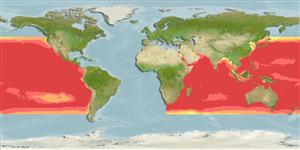Classification / Names
Common names from other countries
Main reference
Size / Weight / Age
Max length : 420 cm TL male/unsexed; (Ref. 30874); common length : 290 cm TL male/unsexed; (Ref. 9308); max. published weight: 440.0 kg (Ref. 30874)
Length at first maturity
Lm 210.0, range 190 - ? cm
Environment
Marine; pelagic-oceanic; oceanodromous (Ref. 51243); depth range 0 - 200 m (Ref. 43)
Climate / Range
Subtropical; 20°C - 25°C (Ref. 54918), preferred 28°C (Ref. 107945); 46°N - 47°S, 19°E - 69°W (Ref. 54918)
Distribution
Indo-Pacific: tropical, subtropical and temperate waters. Highly migratory species, Annex I of the 1982 Convention on the Law of the Sea (Ref. 26139).
The distribution in the Pacific Ocean is unique among billfishes and tunas in that it forms a horseshoe-shaped pattern from the northwest Pacific through the eastern Pacific to the southwest Pacific (Ref. 30443). In the Indian Ocean, fish are more densely distributed in equatorial regions with higher concentrations off eastern Africa, in the western Arabian Sea, the Bay of Bengal and off northwestern Australia (Ref. 30444).
Countries | FAO areas | Ecosystems | Occurrences | Introductions
Short description
Dorsal
spines
(total): 0;
Dorsal
soft rays
(total): 42-48;
Anal
spines: 0;
Anal
soft rays: 18 - 24. Body elongated and compressed; upper jaw produced into a robust and medium sized beak; two dorsal fins, the height of the first greater than the greatest depth, short anteriorly, taller in the middle, then becoming shorter posteriorly; pectoral fins falcate and flexible, with 18 to 22 rays; body densely covered by small, embedded scales with 1 or 2 bluntish points; back dark blue; belly silvery; membrane of first dorsal fin blue black without dark spots; flanks with about 20 bluish stripes (Ref. 55763). Blue-black above and silvery white below, with about 15 rows of cobalt-colored stripes; 1st dorsal fin dark blue; other fins dark brown, sometimes with a tinge of dark blue; anal fin bases with a tinge of silvery white.
IUCN Red List Status (Ref. 115185)
Threat to humans
Harmless
Human uses
Fisheries: commercial; gamefish: yes
More information
ReferencesAquacultureAquaculture profileStrainsGeneticsAllele frequenciesHeritabilityDiseasesProcessingMass conversion
Tools
Special reports
Download XML
Internet sources
Estimates of some properties based on models
Phylogenetic diversity index
PD50 = 0.7505 many relatives (e.g. carps) 0.5 - 2.0 few relatives (e.g. lungfishes)
Trophic Level
4.5 ±0.77 se; Based on food items.
Resilience
Low, minimum population doubling time 4.5 - 14 years (rm=0.09; K=0.2-0.6; tm=2-3; Fec=90-281 million (annual reproductive output))
Vulnerability
Moderate vulnerability (43 of 100)
Price category
